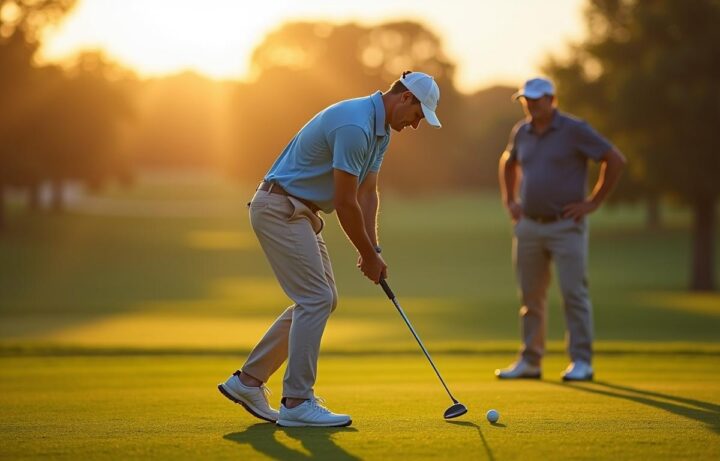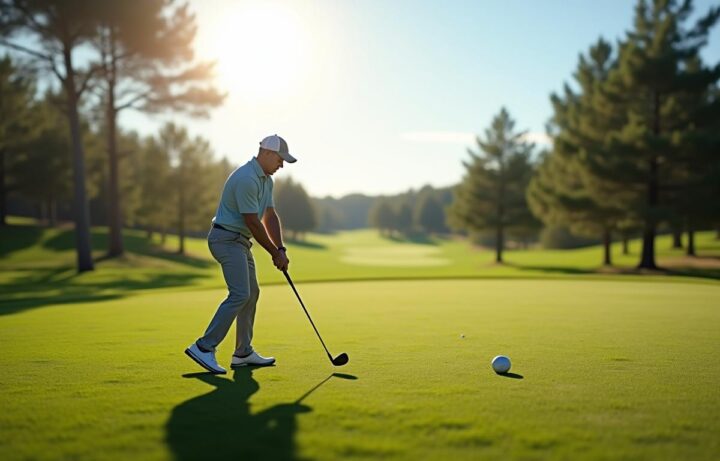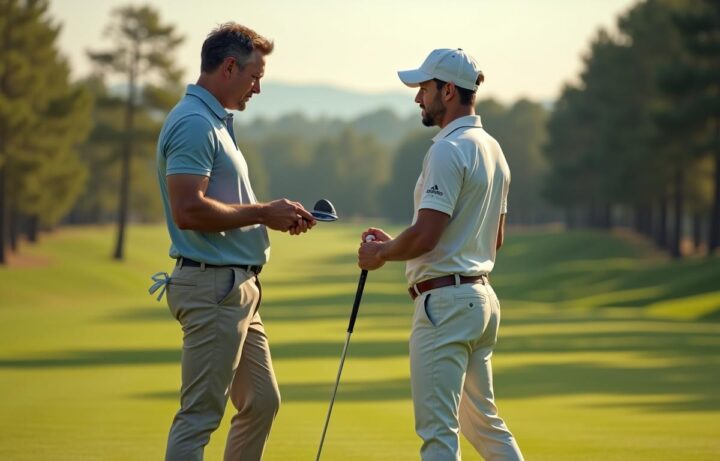How to Fix a Slice in Golf
Nine out of ten golfers can’t figure out how to fix a slice in golf. It’s one of the most frustrating problems they face on the course. The ball curves away from the target because the clubface stays open at impact. This creates a glancing blow that cuts both distance and accuracy by a lot. The ball’s dramatic curve away from target often leads to trouble areas, unlike a hook.
Most players think they need to completely rebuild their swing to fix a slice. The truth is simpler – you just need to understand what’s causing it. Your grip makes a big difference. Players who slice usually have a weak grip, but this can be fixed by turning their hands away from the target. Your choice of equipment also matters a lot when you’re trying to fix a slice with a driver. Many players hurt their chances by picking drivers with too little loft, which makes their slice even worse.

You can learn to fix your golf slice with a driver in just 2 minutes by adjusting your setup and grip. Success comes from developing an in-to-out swing path while keeping the clubface under control. Even the worst slicers can turn their slice into a gentle fade or create a powerful draw with practice. This piece offers tested ways to stop slicing your driver permanently – that’s why these tips became the most-read slice fix article of 2022.
Get the Right Equipment to Stop Slicing
The right equipment can help you reduce your slice right away, even though technique plays a vital role in long-term improvement. Your clubs might actually make your slice worse, but most golfers don’t know this. You need to understand how your equipment affects ball flight to fix your slice.
Check Your Driver Loft and Shaft
Your driver’s loft could be why you’re having trouble fixing your slice. A higher loft creates more backspin that helps keep your ball flight stable and cuts down the side spin that makes the ball slice. You should use a driver with at least 10.5 degrees of loft if you slice the ball, and more loft might help even more. Many golfers think lower loft helps them hit farther, but it usually makes a slice worse.
The flex of your shaft also helps control a slice. Pro golfers often use stiff shafts with stable tip sections, but amateur slicers should get shafts with softer tip sections. Your clubhead releases better through impact with a flexible shaft, which squares the face at the right moment. If you slice with a stiff shaft, switching to a regular or senior flex might straighten your drives without changing your swing.
Players often pick their clubs based on what pros use instead of what matches their swing. This choice gives them clubs that make their slice worse rather than better. A slice needs specific equipment adjustments to turn into a gentle fade, though hooks can be easier to control sometimes.
Why Adjustable Drivers Help Fix a Slice
New adjustable drivers have changed the game for golfers trying to fix their slice. These advanced clubs give you several ways to curb a slice:
- Weight Distribution – Today’s drivers let you move weights around to change ball flight. More weight in the club’s heel helps the toe release better, which naturally squares the face at impact. This small change can cut down the open face that causes slices.
- Hosel Adjustments – The adjustable hosel helps fix a slice more than most people realize. Setting your driver to “draw” position closes the face angle when you address the ball. This works great with higher loft settings to stop slices almost right away.
- Draw-Biased Models – Many brands now sell draw-biased drivers with built-in heel weighting. These clubs can move your shots up to 25 yards closer to your target line. They’re worth looking at if you want to fix your golf slice with a driver quickly.
Custom fitted clubs that target your specific slice tendencies work best. Some new drivers even have special designs that help square the clubface by speeding up the toe during your swing.
Technology can give you a head start toward straighter, longer drives while you work on your technique. Don’t just fight your slice with practice – let your equipment help you improve faster.
Fix Your Grip to Control the Clubface
Your grip is your only physical connection to the golf club. It’s the foundation that helps you control your slice. Right-handed golfers should know that their left hand alone controls 70 percent of the clubface at impact. You’ll need to understand and adjust this vital component to become skilled at fixing a slice in golf.
What a Weak Grip Looks Like
A weak grip happens when your hands rotate too far toward the target on the club. Right-handed players will notice their left hand rotates outward with fewer knuckles visible from above at address. The right hand usually sits more on top of the club and doesn’t stay active during the swing. This hand position naturally leaves the clubface open through impact – a perfect recipe for a slice.
Look at your grip and you’ll see “V” shapes between your thumbs and forefingers pointing toward your left shoulder with a weak grip. This position sets up your hands to deliver an open clubface at impact, whatever swing improvements you make. We noticed that slicers often grip the club in their palms instead of their fingers, which reduces control even more.
How to Create a Stronger Grip
You can create a stronger grip to fix your slice with a driver by rotating both hands away from the target (to the right for right-handed golfers). A good strong grip should show two to three knuckles on your left hand when you look down in address position. The “V” shapes your thumbs and forefingers make should point toward your right shoulder, not your left.
The club should run diagonally across your fingers for the best control – not straight across your palm. Next, put your right hand on the club so your palm’s lifeline covers your left thumb. This creates a grip where both hands work together instead of fighting each other.
There’s another reason people often miss – finger placement. Your right index finger should wrap around the side or under the shaft instead of sitting on top. This gives you better clubface control. This position might feel strange at first, but you need to practice until it feels natural.
Grip Pressure and Hand Alignment Tips
Grip pressure plays a big part in fixing your golf slice with a driver quickly. In stark comparison to this common advice about holding the club “like a baby bird,” you need enough pressure to stay in control during your swing. But don’t strangle the club. Tom Watson suggests gripping tighter with your left hand’s last three fingers to stop a hook. A lighter grip pressure in the left hand can help prevent a slice.
Finger pressure works better than palm pressure. You’ll get better control and distance by gripping the club with your fingers instead of your palms. Yes, it is true that a fingertip grip lets your wrists move correctly, which leads to straighter shots and more distance than a hook.
Hand alignment forms the foundations of proper clubface control. Both hands working together help deliver a square clubface through impact. Any gap between your fingers makes you lose control, so keep your hands snugly together. You can stop slicing your driver by making sure both thumbprints stay on the club throughout your swing. This gives you maximum stability.
These basic grip adjustments are key to fixing your slice in golf before trying anti-slice drivers or custom fitted clubs. Practice consistently with your new grip and you’ll soon see your frustrating slice turn into a gentle fade or even a controlled draw.

3-Step Drill to Fix a Slice in Golf
You’ve got your equipment dialed in and perfected your grip. The next step focuses on swing mechanics that will reshape your game. A slice in golf needs the right practice drills to reprogram your muscle memory. I’ve tested countless anti-slice methods during my golf travels. This 3-step drill stands out as the quickest way to achieve lasting results.
Step 1: Draw a Backward Loop
The solution to fixing your slice starts by replacing your current swing loop. Most slicers pull the club inside on the backswing and loop over the top(see topping the ball) on the downswing. We need to create the opposite motion—a backward loop.
Check your new stronger grip and take your normal stance with the ball positioned inside your front heel. Set the clubhead in front of the ball instead of behind it. Your hands should draw a clockwise circle slowly. Swing the club toward the target, continue over your head, then down and over the ball. This looping motion deserves your complete attention. The club naturally drops to a shallower plane as it approaches the ball. This makes it easier to release your hands properly—a vital aspect of fixing a slice in golf.
Step 2: Add a Shoulder Turn
The simple backward loop needs body rotation. Keep the same clockwise motion as you add your shoulder turn. The clubhead starts behind the ball and lifts up over your head until your hands reach in front of your face.
Turn your shoulders back from this position. The clubface should stay on the shallower plane you created in step one. Swing over the ball next. This creates half of the clockwise loop—from over your head down to the ball. The inside path you need to stop slicing your driver comes naturally.
Step 3: Turn and Release into the Ball
The practice drill now becomes an actual golf swing. Start by lifting the club to a two-thirds backswing position. Your lead arm should be in front of your chest. Complete your full backswing turn and move from swinging over the ball to making real contact.
The backward loop feeling from step one should stay with you. Players at any handicap level can use this method to fix a golf slice with driver quickly. A reliable right-to-left ball flight emerges. This proves more forgiving than a hook, unlike developing a gentle fade that needs more finesse.
Master each step before combining them to fix your slice in golf with a driver. Take it slow at first. Custom fitted clubs can boost these technique improvements. Standard equipment works just as well with this drill. Regular practice makes this new motion feel natural.
Transition from Drill to Real Swing
Learning the 3-step drill is just the start of your trip to fix a slice in golf. The biggest challenge lies in moving these techniques into your actual swing on the course. My worldwide golf experiences show this transition phase makes all the difference in permanent slice correction.
Start with Half Swings
Practicing in slow motion helps you develop proper clubface control. Your first step should be making half swings at 50% speed while keeping the backward loop feeling. These controlled movements build muscle memory better than full-speed attempts. Picture yourself at the range with a bucket of balls, hitting only half swings—this targeted practice matches what top instructors suggest to build the right feel.
“I many times go to the range and hit full buckets only with 1/2 swings,” notes one teaching pro who specializes in how to fix a slice in golf. A limited backswing helps prevent loss of control that happens when golfers overswing, especially those working to stop slicing their driver.
Feel the Inside-out Path
Place a tee just outside your target line, slightly behind the ball to develop the proper path. You need to hit the ball without striking the tee on your downswing. This creates an inside-to-out path that’s vital to fix a slice in golf.
Think about swinging toward 1:00 on a clock face in front of you. This mental picture naturally creates the inside path needed to eliminate your slice. Your main goal should be feeling the clubhead stay slightly behind your hands during the downswing—the opposite of the over-the-top move that leads to slicing.
Watch for Right-to-left Ball Flight
Your ball flight will change right away when you do this correctly. The clubface impact controls about 75% of ball flight and the swing path influences 25%. Face control becomes essential to fix a golf slice with driver in 2 minutes.
Look for the ball to start straight and curve gently from right to left as you practice. This shows your face lines up properly at impact with your new inside-out path. This right-to-left flight works better than a hook, giving you both distance and control.
Players using custom fitted clubs or an anti slice driver see faster results since their equipment supports the new swing path. With enough practice, what feels strange now will become your natural swing. You’ll end up hitting either straight shots or gentle fades based on your release point.

How to Fix a Golf Slice with Driver in 2 Minutes
My experience at Pebble Beach taught me something surprising – you don’t need months of practice to fix a slice in golf. A couple of quick adjustments can make a huge difference to your ball flight in just two minutes!
Quick Setup Changes
The first thing to check is your ball position. Players who slice often place the ball too far forward, which leads to that dreaded outside-to-in swing path. Right-handed golfers should place the ball opposite their left heel instead of their big toe. Sometimes, moving the ball back in your stance helps you avoid swinging across the ball.
Your alignment needs special attention. Many golfers who can’t fix their slice end up aiming left as a way to make up for it. This only makes things worse! A slightly closed stance works better – it helps create an inside-out path that you need to stop slicing your driver.
Fast Grip Check
Let’s look at your grip. A proper driver grip should show 2-3 knuckles on your left hand when you look down at address. Your right hand should rest more on the side of the grip or a bit underneath.
Make sure your grip isn’t too heavy in the palms. Custom fitted clubs can help you improve, but the wrong grip will hold you back. The club should run diagonally across your fingers, not straight across your palm. This simple change can make your ball flight much better than a hook, which usually happens with an overly strong grip.
Simple Swing Thought to Stop Slicing
The best way to fix a golf slice with your driver in 2 minutes is to “swing toward the curve”. It might seem strange, but if your ball slices right, you should focus on swinging more to the right.
Picture a clock face in front of you and try to swing toward 1:00 instead of 11:00. This helps create the inside-out path you need for a gentle fade rather than a slice.
Impact spray on your clubface will show where you’re hitting the ball. Most slicers hit toward the heel – try to move your contact point more toward the center or toe for better results. These quick fixes, along with an anti-slice driver, will help you see better ball flight right away.
How to Fix A Slice in Golf Frequently Asked Question
What is the Main Cause of a Slice in Golf?
A slice is primarily caused by an open clubface at impact combined with an out-to-in swing path. This imparts side spin on the ball, causing it to curve dramatically to the right for right-handed golfers.
How can I Fix My Grip to Reduce Slicing?
To fix your grip, rotate both hands away from the target (to the right for right-handed golfers). Aim to see 2-3 knuckles on your left hand at address. Ensure the club runs diagonally across your fingers, not straight across your palm.
What Equipment Changes can Help Minimize a Slice?
Consider using a driver with at least 10.5 degrees of loft and a more flexible shaft. Adjustable drivers with movable weights and draw-biased settings can also help promote a straighter ball flight.
Is There a Quick Drill to Help Correct a Slice?
Try the backward loop drill: Start with the clubhead in front of the ball, draw a clockwise circle over your head, then down to the ball. This promotes a shallower, inside-out swing path that can help reduce slicing.
How Long does It Typically Take to Fix a Slice?
The time to fix a slice varies depending on the individual and practice frequency. Some golfers see improvements within a few range sessions, while others may take several months of consistent practice. Taking lessons from a professional can often accelerate the process.
Can Tee Height Affect My Slice?
Yes, tee height can influence your swing path and angle of attack. Teeing the ball too low may encourage a steep, over-the-top swing that promotes slicing. Try teeing the ball higher to encourage an upward strike with a more inside-out path.
Does My Stance and Alignment Contribute to Slicing?
Improper stance and alignment can cause slicing. If your shoulders and feet are aimed left of the target (for right-handed players), it encourages an out-to-in swing. Align your feet, hips, and shoulders parallel to your target line to promote a straighter shot.
How Important is Clubface Control in Preventing a Slice?
Clubface control is critical in preventing a slice. Even with a good swing path, an open clubface at impact will still cause the ball to curve right. Focus on square contact and finishing with the clubface pointing toward your target.
Can Swing Tempo Help Eliminate a Slice?
Yes, swing tempo plays a role in slicing. A rushed downswing can cause the upper body to dominate, leading to an over-the-top move. Slowing down your transition and maintaining rhythm can help promote better swing sequencing and reduce slicing.
Should I Use a Different Ball Type to Reduce Slicing?
Using a low-spin golf ball can help reduce the amount of side spin generated on mishits. Some models are specifically designed to reduce slice spin and promote straighter flight, making them a helpful equipment change for frequent slicers.


